Orchids A - Z
Testicle Plant?
Who would suspect at the sight of an orchid that the name translated means testicle plant? It comes from the Greek word "orchis", which means testicles.
This quirky name arises from the testicle-shaped root of the marsh orchids, which represent only one of many genera of the Orchidaceae, but are eponymous for the entire plant family.
Huge variety
There is a variety like no other houseplant. Iridescent colors and wild patterns, beguiling fragrances and ornately shaped flowers, which can only be a few millimeters or almost twenty centimeters in size, make orchids one of the most popular houseplants.
As a result, gardeners have been breeding new varieties since the end of the 19th century (more than 50 new varieties have been created at that time), making the Orchidaceae the largest plant family, with more than 30,000 species.

Aeranthes grandiflora (Jgpfl.)
- flower season: winter - spring
- temperature: moderate (16 - 20 °C)
- Mehr Details

Aliceara Renaissance 'White' (2 Rispen)
- flower season: winter - spring
- temperature: moderate (16 - 20 °C)
- Mehr Details

Baptistonia echinata
- flower season: winter - spring
- temperature: moderate (16 - 20 °C)
- Mehr Details
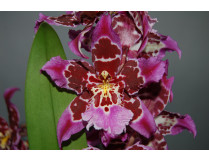
Beallara Joe's Drum Hybride (2 Rispen)
- flower season: winter - spring
- temperature: moderate (16 - 20 °C)
- Mehr Details

Beallara Joe's Drum Hybride (Jgpfl.)
- flower season: winter - spring
- temperature: moderate (16 - 20 °C)
- Mehr Details

Beallara Torrero (Jgpfl.)
- flower season: winter - spring
- temperature: moderate (16 - 20 °C)
- Mehr Details
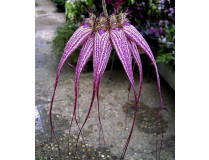
Cirrhopetalum Elisabeth Ann Buckleberry (in Blüte/Knospe)
- flower season: winter - spring
- temperature: moderate (16 - 20 °C)
- Mehr Details

Colmanara Catathante 'Pacific Sunspots' (1 Rispe)
- flower season: winter - spring
- temperature: moderate (16 - 20 °C)
- Mehr Details

Colmanara Massai 'Red' (2 Rispen)
- flower season: winter - spring
- temperature: moderate (16 - 20 °C)
- Mehr Details

Colmanara Massai 'Red' (Jgpfl.)
- flower season: winter - spring
- temperature: moderate (16 - 20 °C)
- Mehr Details
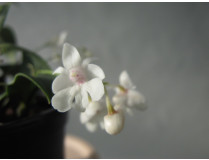
Dendrobium abberans
- flower season: winter - spring
- temperature: moderate (16 - 20 °C)
- Mehr Details

Dendrobium aggregatum
- flower season: winter - spring
- temperature: moderate (16 - 20 °C)
- Mehr Details

Dendrobium Comet King 'Akasuki' (2 Blütenstiele)
- flower season: winter - spring
- temperature: moderate (16 - 20 °C)
- Mehr Details

Dendrobium loddigesii
- flower season: winter - spring
- temperature: moderate (16 - 20 °C)
- Mehr Details

Dendrobium Nagase Mini-Purple
- flower season: winter - spring
- temperature: moderate (16 - 20 °C)
- Mehr Details

Dendrobium pendulum
- flower season: winter - spring
- temperature: moderate (16 - 20 °C)
- Mehr Details

Dendrobium Spring Dream 'Apollon' (2 Stiele)
- flower season: winter - spring
- temperature: moderate (16 - 20 °C)
- Mehr Details

Dendrobium Sunny Bird (2 Rispen)
- flower season: winter - spring
- temperature: moderate (16 - 20 °C)
- Mehr Details

Dendrobium Sunny Eyes (2 Rispen)
- flower season: winter - spring
- temperature: moderate (16 - 20 °C)
- Mehr Details
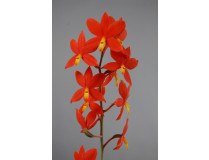
Encyclia vitellina (Jgpfl.)
- flower season: winter - spring
- temperature: moderate (16 - 20 °C)
- Mehr Details

Encyclia vitellinum x cochleatum (in Knospe/Blüte)
- flower season: winter - spring
- temperature: moderate (16 - 20 °C)
- Mehr Details

Laelia lundii
- flower season: winter - spring
- temperature: moderate (16 - 20 °C)
- Mehr Details

Laelia lundii 'alba'
- flower season: winter - spring
- temperature: moderate (16 - 20 °C)
- Mehr Details

Laelia lundii 'alba' (Jgpfl.)
- flower season: winter - spring
- temperature: moderate (16 - 20 °C)
- Mehr Details

Laelia lundii 'coerulea'
- flower season: winter - spring
- temperature: moderate (16 - 20 °C)
- Mehr Details

Masdevallia Amazone 'Dracona'
- flower season: winter - spring
- temperature: moderate (16 - 20 °C)
- Mehr Details

Masdevallia Amazone 'Samantha' (2-3 Stiele)
- flower season: winter - spring
- temperature: moderate (16 - 20 °C)
- Mehr Details

Masdevallia ignea x Amazone 'Dracona'
- flower season: winter - spring
- temperature: moderate (16 - 20 °C)
- Mehr Details

Masdevallia Selphi Orion
- flower season: winter - spring
- temperature: moderate (16 - 20 °C)
- Mehr Details

Masdevallia Southern Sun
- flower season: winter - spring
- temperature: moderate (16 - 20 °C)
- Mehr Details
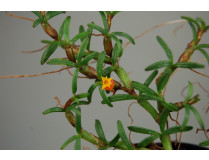
Mediocalcar decoratum
- flower season: winter - spring
- temperature: moderate (16 - 20 °C)
- Mehr Details

Miltonidium Sweet Cherry (2 Rispen)
- flower season: winter - spring
- temperature: moderate (16 - 20 °C)
- Mehr Details

Miltoniopsis Hybride (3-4 Rispen)
- flower season: winter - spring
- temperature: moderate (16 - 20 °C)
- Mehr Details

Odontocidium Remember Burkhard Holm (2 Rispen)
- flower season: winter - spring
- temperature: moderate (16 - 20 °C)
- Mehr Details

Odontocidium Remember Burkhard Holm (Jgpfl.)
- flower season: winter - spring
- temperature: moderate (16 - 20 °C)
- Mehr Details
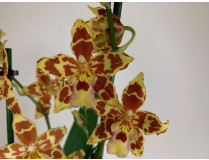
Odontocidium Tiger Tail (2 Rispen)
- flower season: winter - spring
- temperature: moderate (16 - 20 °C)
- Mehr Details
Ideal for hobby gardeners
For hobby gardeners, they are particularly exciting, because some species need many years to first flowering, some can even be decades old and growing young plants is a small challenge. At the same time, it is also ideal for beginners. Because they are frugal and do not want to be watered too often, they are not that complicated to care for.
Orchids are a noble crop
What we admire as a jewel on the windowsill was used as a crop by the indigenous people of Southeast Asia and South America. For example, cymbidiums and coelogynes were used as food plants in tropical countries, in Asia spathoglottis and coelogyne were popular vegetables and some dendrobium species were used as wicker in the Philippine and Indonesian areas.
It was even used as a medicinal plant and as an aphrodisiac.
The queen of plants
They love sunny and airy around the roots, from time to time it may be a bit of water. Therefore, many tropical species have chosen instead of perching on the forest floor on the branches of trees or even on bare rock. They are therefore called Aufsitzer or Epiphyten (from the Greek "epi" = on and "phyton" = plant). But even if they are so hungry they do not draw nutrients out of the trees, but eat everything they can catch on the branches or from the air.
Phalaenopsis is particularly clever and uses the sublime site to do photosynthesis not only with the leaves but also with the roots, so we cultivate them in transparent pots at home. In the temperate zones, especially terrestrial so-dwelling orchids are widespread, as they cope better with the prevailing climate fluctuations.
Some orchids are quite crafty plants. The flower of the genus Orphys mimics the shape of a female insect. Thus, she attracts mating male insects, which help her involuntarily in the pollination.
A long journey
In the Antarctic and the desert orchids are too uncomfortable. Apart from that, they are found all over the world, especially in tropical Asia, where around 14,000 species are native. Also in Europe a few species are native, for example the Nestwurz or the Korallenwurz.
The first orchids that landed on our window sill came to us in the 17th century from distant lands with Spanish seafarers. The exotic beauties with their weird roots and wondrous flowers created a huge fascination. At that time they were prestige objects that only the rich nobility could afford. Many collectors plunged into deprived expeditions to find new wondrous species.
But mass imports reduced their exclusivity at the beginning of the 19th century, and at the end of the 19th century they finally found the decisive trick to breed them. Because the tiny orchid seeds do not have their own nutrients, they are dependent on a filamentous fungus. This penetrates into the seed and is used by the seedling as a source of food.
But where to take and not steal?
Thanks to modern propagation methods, orchids are nowadays affordable and they even exist as cheap goods in the discounter.
Who takes wild orchids home from nature endangers their survival. The occurrence of many species is decreasing worldwide as their habitats are destroyed due to agricultural use and rainforest deforestation. If you want a special species, it is best for the breeder, because there is a wide range of natural forms and hybrids and numerous new varieties.


 ... to newsletter subscription
... to newsletter subscription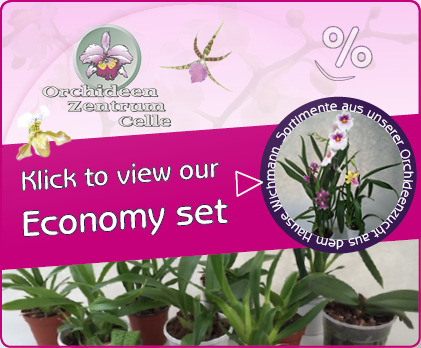 ... to see all economy sets
... to see all economy sets


























